Maximize Your Kiteboarding with the WeatherFlow Wind Meter
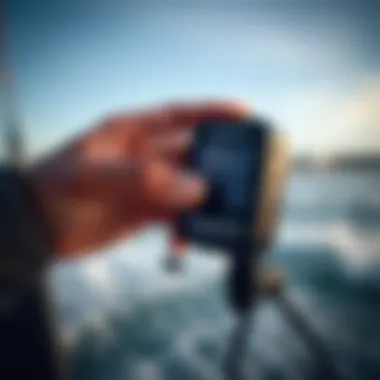
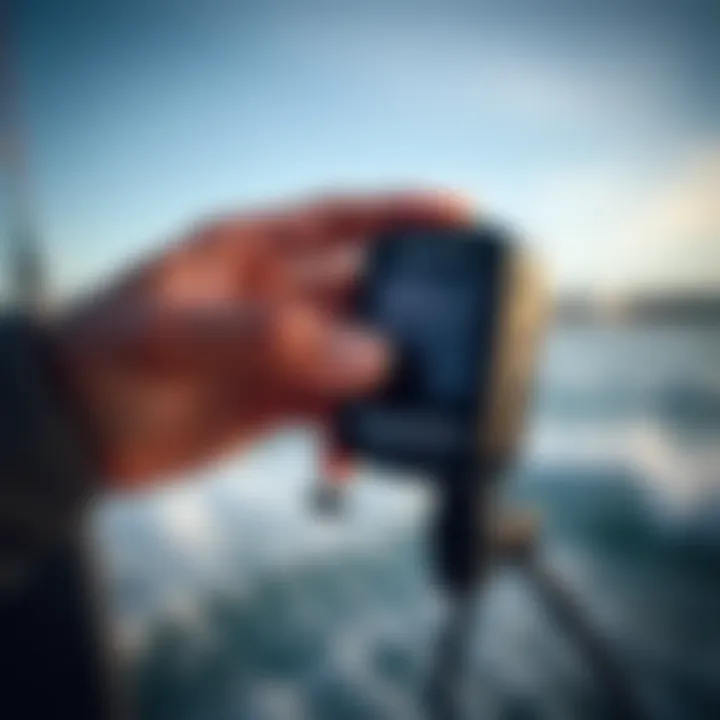
Intro
The relationship between kiteboarding and wind is as intertwined as a kite string in a gusty breeze. The WeatherFlow Wind Meter emerges as a game changer for kiteboarders seeking to harness nature’s unpredictable elements. With the ocean's thrill and the skies above, accurate wind data transforms an ordinary session into an extraordinary escapade. In this guide, we’ll delve into the functionalities, practical applications, and the many benefits this device brings to the table.
Whether you’re a rookie feeling the exhilarating rush of your first jump or a seasoned rider pushing the limits with advanced tricks, understanding wind patterns is pivotal. With kiteboarding, knowledge isn’t just power; it’s what keeps you safe and helps you unleash your full potential on the water. Let's take a closer look at the Equipment Insights to set the stage for a fruitful kiteboarding experience.
Prolusion to Wind Measurement in Kiteboarding
Kiteboarding depends heavily on understanding wind dynamics. Without accurate measurements, both safety and performance can take a hit. Getting a grasp of how the wind behaves can mean the difference between an exhilarating ride and a challenging disaster. Seasoned kiteboarders will tell you, it’s all about knowing the wind.
Importance of Accurate Wind Data
Accurate wind data can be a kiteboarder's best friend. Think of it as your GPS, guiding you through the waters while helping you avoid potential hazards.
The wind can change like a chameleon, with shifts not just in speed but also in direction. Misjudging these changes can lead to mishaps. A slight breeze might seem harmless, but when you hit the water, even a gusty surprise can catch you off guard. Here are some key reasons why accurate wind data is crucial:
- Safety: Knowledge of wind patterns can significantly minimize risk. Riders can identify dangerous conditions before they venture out.
- Performance: Better understanding helps in optimizing your techniques to enhance speed and control. Knowing wind strength allows you to make the right equipment choices, ensuring optimal performance on the water.
- Planning: It aids in timing session and choosing the best spots based on the day’s conditions. You wouldn’t want to show up at a location that’s dead flat while your buddies are scoring with howling winds elsewhere.
"In kiteboarding, the wind is both your best ally and most formidable adversary. Master its behavior and you master the sport."
Overview of Wind Measurement Tools
Wind measurement tools have evolved dramatically over the years, catering to both amateurs and professionals. Understanding what’s available will help you make informed decisions.
- Anemometers: These are devices designed specifically for wind measurement. They can be handheld or stationary, giving readings on speed and sometimes direction. Most commonly, kiteboarders will use handheld anemometers due to their portability.
- Smartphone Apps: Many kiteboarders now rely on applications to provide real-time data. These can use data from local weather stations as well as community reports, adding to the accuracy.
- Weather Stations: For those who like to get nerdy, personal weather stations can provide a comprehensive view of near-field data. They measure various conditions, not only wind speed but also temperature and humidity, giving you a broader picture.
- Online Platforms: Websites and forums can aggregate data from various sources and offer forecasts. Engaging in community discussions can lead to shared insights that may not come from simply relying on apps or devices.
Overall, melding these tools with personal experience leads to smarter kiteboarding. Each tool has its place, and understanding their strengths can support your activities on the water. Being well-equipped with knowledge and gear allows you to ride with both confidence and gusto.
Introducing the WeatherFlow Wind Meter
In the world of kiteboarding, understanding wind conditions is paramount. This is where the WeatherFlow Wind Meter steps in, transforming how enthusiasts gauge what’s happening above their heads. The need for precise wind data cannot be overstated, as it directly influences decision-making on the water. Unlike simply relying on what is posted on local weather apps, having a portable, accurate device enables kiteboarders to assess conditions on-site. This section delves into what makes the WeatherFlow Wind Meter a cornerstone for kiteboarding lovers.
What is the WeatherFlow Wind Meter?
At its core, the WeatherFlow Wind Meter is more than just another gadget; it's a lifeline for kiteboarders looking to optimize their experience. This sleek device acts as a personal wind gauge, harnessing cutting-edge technology to deliver real-time data. Standing out in the crowd, it pairs easily with smartphones and tablets via Bluetooth, allowing users to visually monitor wind conditions through a dedicated app.
In essence, it measures average wind speed, gusts, and direction. The information gathered is invaluable in making informed choices about when and where to kiteboard, ensuring safety and enhancing enjoyment. The simplicity of its operation, combined with its technological prowess, spells a win for both rookies and veterans alike.
Key Features and Specifications
When exploring the functionality of the WeatherFlow Wind Meter, several features make it particularly noteworthy:
- Real-Time Data: Offers accurate wind readings instantly, so you know when the conditions are just right.
- Durability: Designed to withstand the ruggedness of outdoor conditions, it features a tough exterior that can handle slips or drops.
- Compatibility: Seamlessly connects to both iOS and Android devices, creating an integrated user experience.
- Compact Size: Portable and lightweight, just slip it into your pocket or attach it to your gear.
- Battery Life: Comes with a long-lasting battery that keeps the device ready to use whenever the wind beckons.
These fundamental characteristics elevate the WeatherFlow Wind Meter, making it an indispensable choice for kiteboarders who crave reliability in their tools.
Build Quality and Design Aspects
The design of the WeatherFlow Wind Meter strikes a vital balance between form and function. It is crafted not only for aesthetics but also for practical use in dynamic environments. The sleek design fits comfortably in hand, and it has an intuitive interface, allowing users to operate it without prior experience.
- Ergonomics: Its grip is designed for comfort, even during prolonged usage. The lightweight build doesn’t fatigue your hand, making it easy to check readings frequently.
- Materials: Constructed with high-quality materials, it withstands moisture and light impacts, further contributing to its longevity.
- Visibility: The readings are displayed clearly, ensuring that any kiteboarder with keen eyes can read the data even in bright sunlight.
Each design component reflects a thoughtful approach to what kiteboarders need on the field, enhancing usability without compromising on style or durability.
"The right equipment can be the difference between a fantastic day on the water and a somewhat mediocre one. The WeatherFlow Wind Meter is that equipment."
In summary, the depth of exploration into the functionality and design of the WeatherFlow Wind Meter underpins its significance for kiteboarders. By equipping themselves with such a tool, users not only empower their experience but also cultivate a more informed approach to enjoying the winds.
How to Use the WeatherFlow Wind Meter
The WeatherFlow Wind Meter is designed to offer users a seamless experience when it comes to measuring wind conditions. Understanding how to effectively use this device is crucial not only for maximizing its benefits but also for enhancing overall kiteboarding experiences. Accurate wind measurements allow kiteboarders to make informed decisions on the water, thus ensuring safety and enjoyment.
Setting Up the Device
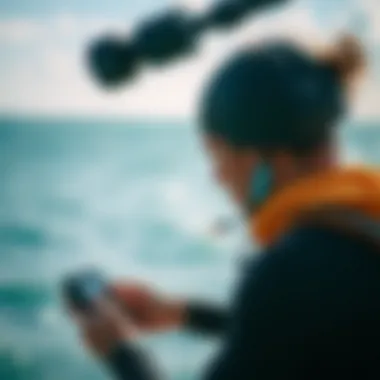
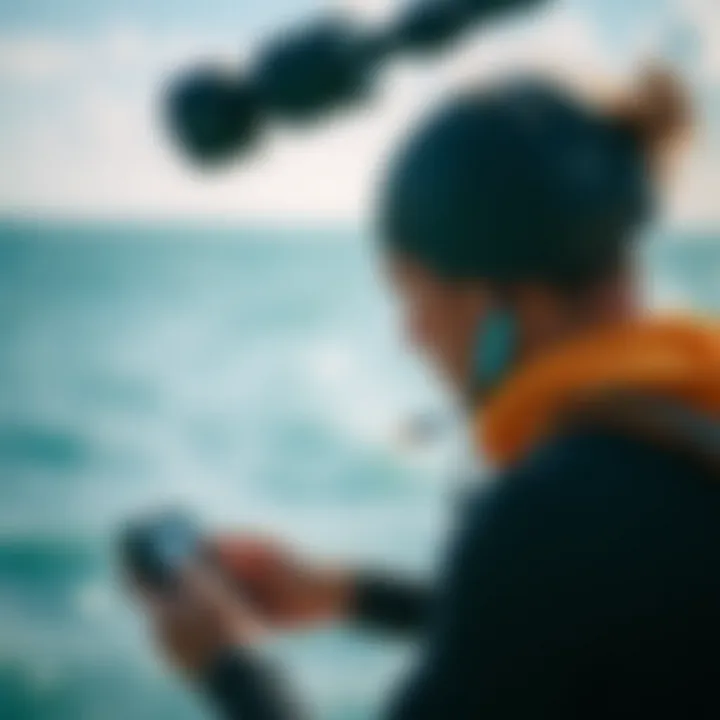
Setting up the WeatherFlow Wind Meter is a straightforward process, vital for first-time users and seasoned kiteboarders alike. To get started, you should first download the WeatherFlow app on your smartphone. It’s available on both Android and iOS platforms. Once you have the app, you’ll need to create an account or log in.
Next, ensure that your device is properly charged. The meter comes with a rechargeable battery, so it’s wise to give it a full charge before your outing. When you’re ready, open the app and follow the prompts to pair your Wind Meter via Bluetooth. This will generally require you to tap on the device name when it appears on your screen. Once paired, you’re all set to start measuring wind.
Keep in mind the location where you set up the device. It should be at least ten feet above the ground for optimal reading accuracy. Ideally, position it where the wind flows freely—obstacles like trees or buildings can skew readings. A clear area helps you get the most precise data, so make sure to choose wisely.
Interpreting Wind Readings
Interpreting the data from the WeatherFlow Wind Meter can seem daunting at first, but once you get the hang of it, you’ll be able to process the information quickly. The Wind Meter displays a variety of metrics including wind speed, direction, and gusts. Each of these metrics serves a specific purpose in kiteboarding.
- Wind Speed is measured in both miles per hour (mph) and kilometers per hour (km/h), allowing you to understand how strong the wind currently is.
- Wind Direction indicates where the wind is coming from, which is crucial for those looking to harness the wind effectively. The device uses degrees—0° represents North.
- Gusts are brief bursts of increased wind speed. Measuring gusts helps users prepare for sudden changes that could affect handling on the water.
Being able to read wind data accurately enables kiteboarders to choose the right techniques and equipment. A wind speed under ten mph might not be conducive for some riders, while others thrive in such conditions. Thus, understanding these readings can significantly influence your choice of kite and style of riding.
Integrating Data with Kiteboarding Apps
The integration of WeatherFlow data with kiteboarding apps can truly enhance your kitesurfing or kiteboarding experience. Many kiteboarding apps allow you to import real-time wind data directly from your Wind Meter.
To connect your Wind Meter data with these apps, follow these steps:
- Open the Kiteboarding App: Make sure it’s up-to-date.
- Navigate to the Settings: Look for an option to integrate external wind data.
- Select WeatherFlow Wind Meter: Follow the specific prompts to sync.
Many popular apps like KiteMate or Windy have features that leverage this data, giving you personalized wind forecasts, spot suggestions, and even optimal launch times. It’s a great way to have real-time insights at your fingertips, ultimately enabling you to make smarter, safer decisions on the water.
"The integration of live wind data with your favorite kiteboarding app transforms planning your sessions into a breeze."
Understanding how to utilize the Wind Meter effectively ensures that you are always ahead of the game. By mastering these tools, you’ll not only enhance your kiteboarding experience but also become a more informed rider.
Practical Applications for Kiteboarding
Understanding the practical applications of the WeatherFlow Wind Meter is crucial for kiteboarders who want to make the most out of their time on the water. Kiteboarding demands a nuanced awareness of wind conditions, which directly impacts performance and safety. Having access to real-time wind data not only informs kiteboarders about current conditions but also enhances strategic planning, ensuring every session is both enjoyable and productive.
Choosing the Right Spot Based on Wind Conditions
Identifying the ideal kiteboarding location is heavily reliant on accurate wind measurements. With the WeatherFlow Wind Meter, you can assess local wind conditions before heading out. Here’s how:
- Analyze Wind Patterns: By gathering data on wind direction and speed, kiteboarders can understand local patterns. For instance, coastal regions often have varying winds based on topography or geography. Armed with this knowledge, one can choose a spot that maximises both fun and safety.
- Local Insights: Remember to check community forums on platforms like reddit.com where local kiteboarders share their experiences and insights about wind conditions. This complements the data from the Wind Meter, ensuring you get a comprehensive view.
- Consider Launch Areas: Areas that provide clear launch spots without obstructions are generally preferred. Use the Wind Meter to find locations where wind speed is optimal for your skill level, allowing for ease of takeoff and landings.
Adjusting Technique According to Wind Speed
As any seasoned kiteboarder knows, wind speed can vary significantly throughout the day. It’s critical to adapt your technique accordingly. Here’s how the WeatherFlow Wind Meter can aid in these adjustments:
- Gear Selection: The Wind Meter helps determine which kite size is appropriate for the existing wind conditions. For example, higher winds may necessitate smaller kites to maintain control.
- Riding Style Modifications: With real-time data in hand, you can alter your riding style effectively. Under light wind conditions, emphasis might be placed on fluid movements and continuous board speed, contrasting with the aggressive techniques suited for high wind.
- Switching Tactics: If the wind picks up unexpectedly, being prepared to change tactics can be a game changer. For instance, in stronger winds, lighter tricks might transition into more techy maneuvers that capitalize on the increased speed.
Safety Considerations Linked to Wind Data
Safety should be paramount whenever you’re out kiteboarding. The WeatherFlow Wind Meter offers a wealth of data that can support safer riding experiences:
"Being aware of your surroundings and real-time wind data could save lives on the water."
- Assessing Storms: Sudden gusts or shifts in wind speed may indicate impending storms. Keeping an eye on the Wind Meter allows you to monitor these changes in real-time and make timely decisions about entering or exiting the water.
- Setting Safe Boundaries: Different skill levels may dictate where a kiteboarder should operate. Those with less experience may want to avoid high wind areas or crowded spots, utilizing the data to find calmer zones.
- Emergency Preparedness: Being able to interpret wind data can help in emergency situations, enabling you to navigate back to shore or find a safe area to land your kite when necessary.
In summary, the practical applications of the WeatherFlow Wind Meter in kiteboarding extend beyond mere convenience; they are vital for decision-making, technique adjustments, and ensuring safety while enjoying the sport. In this way, both novice and seasoned kiteboarders can benefit enormously from possessing reliable wind data.
Advantages of the WeatherFlow Wind Meter
The WeatherFlow Wind Meter is more than just another gadget; it’s almost like having a seasoned kiteboarding coach right in your pocket. The advantages offered by this device can significantly enhance the kiteboarding experience, ensuring that both beginners and experts feel confident every time they hit the water. Let’s break down the key benefits that make the WeatherFlow Wind Meter a must-have for those who are passionate about kiteboarding.
Portability and Ease of Use
One of the standout features of the WeatherFlow Wind Meter is its portability. This device is lightweight and compact enough to fit in most pockets, making it a breeze to bring along wherever you go. You could be at the beach, on a boat, or even in a park—this gadget travels well. The ease of use is impressive too. To get started, you simply need to download the app, calibrate your device, and you’re good to go. No technical degree is required. Just point it into the wind and let it do the measuring. It’s designed for how we live and play, allowing quick assessments with little hassle.
Real-Time Wind Data Access

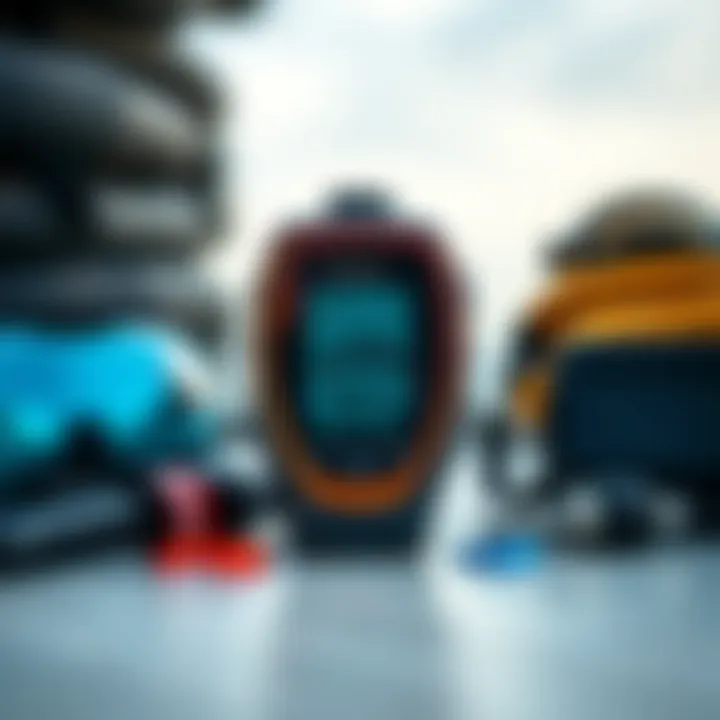
Having quick access to accurate wind data can be the difference between a sun-soaked picnic on the beach and an exhilarating day on the waves. The WeatherFlow Wind Meter provides real-time readings that are updated instantly. This means kiteboarders can make timely decisions—whether to launch or pack up for the day. With this device, you don't have to rely solely on weather forecasts, which can often be misleading or outdated. Instead, you have a live feed of wind speed and direction, facilitating informed decisions on the fly.
User-Friendly App Experience
The integration between the WeatherFlow Wind Meter and its companion app is smooth as silk. Upon connecting your device, you’ll find an intuitive interface that is simple to navigate. Data visualizations make understanding wind conditions a walk in the park. You might find you enjoy looking at trends over time, allowing for a more nuanced plan around kiteboarding sessions. The app also allows you to share your findings with fellow enthusiasts, contributing to a community of kiteboarders who value reliable and timely information. From personal metrics to broader environmental data, the app supports an engaging experience that elevates kiteboarding adventures.
"Having the right wind data at your fingertips can turn any kiteboarding session from ordinary to extraordinary."
In summary, the advantages of the WeatherFlow Wind Meter are compelling. It’s portable, easy to use, provides real-time data, and has an app experience that’s hard to beat. With these features in play, kiteboarders can optimize their time on the water, making the most of every breeze.
Maintenance and Troubleshooting
Taking good care of your WeatherFlow Wind Meter is crucial for ensuring its top-notch performance. Kiteboarding requires precise wind measurements, and a malfunctioning device can seriously hamper your experience on the water. Therefore, maintenance and troubleshooting should not be just an afterthought but a constructive part of your routine. Regular upkeep not only enhances the accuracy of measurements but also extends the device's lifespan, providing kiteboarders optimal functionality time and again.
Routine Cleaning and Care
The importance of routine cleaning can’t be understated. Like any sport gear, the WeatherFlow Wind Meter could end up collecting dust and other residues, especially if it’s frequently exposed to the elements. Here are some basic care tips for keeping the device in shape:
- Use a Soft Cloth: Regularly wipe the device's exterior with a soft, dry cloth. This simple act keeps it free from dirt, moisture, and salt accumulation.
- Avoid Harsh Chemicals: Steer clear of abrasive cleaners. A bit of soap and warm water is typically sufficient.
- Store Properly: When not in use, store the wind meter in a protective case or its original packaging to shield it from physical damage or extreme temperatures.
Keeping the device clean not only enhances its performance but also makes it more pleasant to use over time.
Common Issues and Solutions
Even with the best care, issues can arise. Here’s a look at some common hiccups you might encounter with your WeatherFlow Wind Meter, along with simple fixes:
- Display Issues: If the display isn’t responding, try resetting the device by removing and re-inserting the battery. If problems persist, check for firmware updates in the companion app.
- Inaccurate Readings: If you sense that the measurements seem off, ensure that the device is adequately calibrated. You might need to re-calibrate it following the guidelines provided in the user manual.
- Connectivity Problems: If the wind meter fails to connect to your smartphone, ensure your Bluetooth settings are enabled and restart both devices. Updating the app can also solve connectivity issues.
Enhancing Longevity of the Device
Taking steps to improve the longevity of the WeatherFlow Wind Meter can save you time and money in the long run. Here are some tips that go beyond regular cleaning:
- Battery Maintenance: Always use high-quality batteries and replace them promptly when needed. Old batteries can leak or cause corrosion, which can ultimately harm the device.
- Avoid Prolonged Exposure: While the wind meter is built to handle outdoor conditions, prolonged exposure to extreme weather can take a toll over time. After your kiteboarding session, if there’s heavy rain or intense sun, consider bringing the device indoors.
- Regular Updates: Frequently check for firmware updates within the app. Developers continuously improve functionality, ensuring that your device operates smoothly.
Comparing with Other Wind Measurement Tools
In the world of kiteboarding, having accurate wind information is not just a luxury; it’s essential. Knowing how the WeatherFlow Wind Meter stacks up against other wind measurement tools is crucial for kiteboarders who want to ensure they are riding under optimal conditions. This comparison allows enthusiasts to make informed decisions, whether they're purchasing their first wind meter or looking to upgrade their equipment. Furthermore, it highlights specific features, benefits, and considerations that can ultimately affect performance on the water.
WeatherFlow vs. Competitors
When we talk about wind measurement tools, various brands and models enter the conversation. The WeatherFlow Wind Meter is certainly a standout, but it’s important to see how it measures up against alternatives. Here are some key aspects to consider:
- Accuracy: Few products can match the precision of the WeatherFlow. Devices like the Kestrel or the anemometer from Uni-T, while respectable, often lag behind in providing real-time readings that kiteboarders rely on.
- Ease of Use: Compared to some other devices that can resemble small science experiments, the WeatherFlow has a user-friendly interface. With a straightforward app connection, it offers quick setups, whereas tools like the Speedtech may require a deeper understanding of settings.
- Portability: Many kiteboarders value portability. The WeatherFlow Wind Meter is compact and light, making it a breeze to carry around. Competing products sometimes sacrifice this aspect for additional features.
"In the field of kiteboarding, having clarity on wind conditions can be the difference between an exhilarating ride and an unfortunate tumble."
- App Integration: While several wind meters offer companion apps, the synergy found in WeatherFlow’s app is often noted by users. Competitors like the Kestrel app, although functional, may lack some of the intuitive functionalities that WeatherFlow provides for kiteboarding specifically.
Each of these elements proves meaningful in the dynamic world of wind measurement, influencing what users find most valuable in their gear.
Advantages and Disadvantages
Every product on the market has its strengths and weaknesses. Identifying these in the context of the WeatherFlow Wind Meter against its competitors can help users gauge the right fit for their specific needs in kiteboarding. Here’s a breakdown:
Advantages
- Precision Data: The device excels in providing nuanced wind readings essential for optimal kiteboarding.
- User-Friendly App: A standout feature, which many find easier to navigate than competitor apps.
- Compact Design: Perfect for those who travel light; you won’t notice it’s in your backpack until you need it.
Disadvantages
- Price Point: While many recognize the value in its accuracy, the price may be higher than similar basic models like the ones from Anemometery.com, which could appeal to budget-conscious novices.
- Learning Curve: Although it’s designed to be simple, some users might find the extensive features a bit overwhelming initially.
By weighing the advantages and disadvantages of the WeatherFlow Wind Meter in relation to its competition, kiteboarders can make decisions that align closely with their performance goals and budgetary limits.


User Experiences and Testimonials
In the realm of kiteboarding, user experiences and testimonials hold immense significance. They serve as real-world validation of the WeatherFlow Wind Meter’s claims, showcasing how fellow kiteboarders utilize the tool and the tangible benefits it brings to their sessions. Hearing from actual users can often paint a clearer picture than any marketing statement.
When kiteboarders share their firsthand experiences, it not only adds a personal touch but also helps to build trust in the product. A simple review might emphasize how accurate wind measurements have led to improved performance and safety on the water.
Insights from Kiteboarding Enthusiasts
The kiteboarding community is often vocal about their gear. Enthusiasts talk through forums and social media, sharing their experiences with the WeatherFlow Wind Meter. Many highlight its portability, allowing them to gauge wind conditions anywhere—from bustling beaches on vacation to secluded lakes where wind data can be harder to come by.
Kiteboarders frequently express appreciation for the real-time data capability. One user might say, "Every time I hit the water, I know what the wind's doing. It’s like having a weather station right in my pocket!" This sentiment reflects how crucial accurate readings can be, especially when conditions change quickly.
Users also often praise the intuitive app that accompanies the meter. Another enthusiast comments, "The integration with other apps is seamless. I can adapt my plans based on reliable data, instead of relying on my guesswork or third-party forecasts."
Case Studies and Practical Feedback
Delving deeper into user experiences leads to specific case studies that illuminate the daily realities of using the WeatherFlow Wind Meter. For instance, let's consider a kiteboarding instructional school based in California. The instructors reported significant improvements in lesson planning after incorporating the wind meter.
- Instructors noted that:
- Safety during lessons increased due to reliable wind data.
- Students were able to improve their skills more quickly by learning in optimal wind conditions.
In a particularly windy season, feedback from one of the school's lead instructors revealed how the WeatherFlow Wind Meter not only catered to their instructional needs but elevated their students’ learning experiences. They emphasized that knowing the precise wind speed and direction allowed them to tailor lessons effectively, accommodating different skill levels.
Another pragmatic feedback comes from an avid kiteboarder who frequently travels. They noted how they used the WeatherFlow Wind Meter across various locations to find the best spots. Instead of relying on occasional vague reports from tourist centers, they had more confidence in choosing locations based on their own measurements. A user mentions, "I felt leaps ahead of others at the beach; I could find the windy spots when everyone was clueless!"
These case studies and user testimonials underline the practicality and effectiveness of the WeatherFlow Wind Meter. They provide a comprehensive understanding of how kiteboarders from different backgrounds benefit from this tool, ensuring users can appreciate its value beyond mere technical specifications.
Future Innovations in Wind Measurement
As kiteboarding continues to grow in popularity and technology evolves, wind measurement tools must adapt to meet the demands of enthusiasts on the water. Innovations in this area are not just enhancements; they are necessities that can redefine our understanding of wind conditions and enhance the overall experience for kiteboarders. By exploring new technologies and applications, we can ensure that kiteboarders, both novices and veterans, can make more informed decisions.
Trends in Wind Measurement Technology
The landscape of wind measurement technology is ever-changing. Here are some notable trends:
- Smart Sensors: Modern wind meters are integrating smart technology, allowing them to communicate with smartphones and other devices. This connectivity provides real-time updates, which can be crucial for timely decision-making.
- Enhanced Accuracy: Newer models incorporate high-precision sensors that significantly boost accuracy. This is especially important in dynamic environments where wind conditions can change rapidly.
- Portable Design: Innovations in materials have made wind meters lighter and more durable. This portability means that kiteboarders can easily carry their devices without compromising on functionality.
- Data Analytics: With the introduction of machine learning algorithms, wind data can now be analyzed to predict conditions more accurately. This is particularly beneficial for kiteboarders planning their sessions.
Such trends are indicative of a broader shift towards more user-friendly interfaces and reliable data sources that can aid in kiteboarding assessments.
The Role of IoT in Wind Measurement
The Internet of Things has had a profound impact in various fields, and wind measurement is no exception. Here are some considerations regarding IoT's influence:
- Real-Time Updates: When wind meters are connected to IoT networks, users get instant updates. This can help kiteboarders avoid unfavorable conditions and optimize their outings.
- Data Sharing: When individual devices share data, communities can benefit from collective insights. A group of kiteboarders could track localized wind trends in real-time, offering invaluable information based on a larger pool of data.
- Predictive Models: IoT-enabled systems can utilize historical weather patterns and current data to provide predictions about future conditions. This predictive programming can be a game-changer in planning successful kiteboarding sessions.
- Customization: With IoT systems, users may personalize their alerts for specific wind conditions. Whether you want an alert for wind speeds over a certain threshold or specific gust patterns, the technology allows for detailed customization.
"We are entering an era where kiteboarding decisions can be informed by data as precise as the wind itself."
Innovations in wind measurement go beyond mere convenience. They create a network of empowered users equipped with precise information. In this era of technological advancement, kiteboarders can expect their wind meters to evolve, ensuring safer and more enjoyable experiences on the water.
The End
In wrapping up our exploration of the WeatherFlow Wind Meter, we find it imperative to highlight its significant role in the kiteboarding community. This isn't just a gadget; it's a crucial ally for anyone venturing into the thrilling world of kiteboarding. The device’s precision not only enhances the riding experience but also empowers riders to make informed decisions that can greatly affect their safety and performance on the water.
Summarizing the Benefits of the WeatherFlow Wind Meter
The benefits of the WeatherFlow Wind Meter are manifold and cater to both the beginner just learning the ropes and the seasoned expert. Here are the key advantages it brings to the table:
- Accuracy in Measurements: The device provides real-time data that is essential for gauging wind speed and direction accurately. Knowing these numbers allows kiteboarders to select the best conditions for their skills and equipment.
- Portability: Compact and lightweight, the WeatherFlow Wind Meter fits easily into a pocket or bag, making it an ideal companion for every trip to the beach or kite surfing spot.
- User-Friendly App Integration: The associated app strengthens the device’s capabilities by offering features such as historical data tracking and detailed analytics, giving users a deeper understanding of wind patterns over time.
- Enhanced Safety: With precise wind readings at their fingertips, kiteboarders can avoid dangerous conditions, helping to keep them safe while pursuing their passion.
"Having reliable wind data transformed my kiteboarding sessions from guesswork into precision. Couldn’t imagine going back to the days of merely relying on my instincts."
Encouraging Responsible Wind Measurement Practices
Using the WeatherFlow Wind Meter also comes with a responsibility to practice effective wind measurement. The value it provides can easily be diminished if users do not integrate its data into their routines wisely. Here are some considerations:
- Regular Calibration: Ensure that your Wind Meter is functioning accurately by checking for updates or calibration suggestions from the manufacturer.
- Environmental Awareness: Be mindful of the surroundings when taking measurements. Wind conditions can change rapidly with terrain features obstructing airflow. Always consider local geography and weather phenomena.
- Sharing Information: Consider sharing readings with fellow kiteboarders. Your data could be the differentiator that helps someone else make safer choices.
- Combining Data Sources: Utilize the WeatherFlow data with forecasts from trusted meteorological sources. This dual-layered approach enhances decision-making.
Overall, responsible use of the WeatherFlow Wind Meter means you step into each session armed with knowledge, ensuring not just the thrill of riding but also the safety and enjoyment that comes with it. By understanding and leveraging these measurements thoughtfully, kiteboarders can truly elevate their experience on the water.







